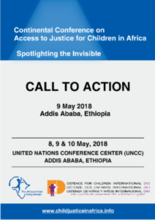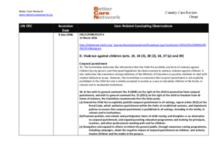Displaying 571 - 580 of 1759
The participants of the Continental Conference on Access to Justice for Children in Africa titled “Spotlighting the Invisible”, held in Addis Ababa, Ethiopia from 8 - 9 May 2018, following up on the 2011 Kampala Conference and its outcomes, have issued a Call to Action "recognizing the adverse and lasting impact that gaps in access to justice have on children in Africa."
El presente reglamento tiene como objeto desarrollar los procedimientos técnicos y administrativos que realiza la Procuraduría de la Niñez y la Adolescencia y sus Delegaciones Regionales en cada una de las materias que la Ley de Protección Integral de la Niñez y la Adolescencia y otros cuerpos legales le asignan.
This study examined data from five cycles over twenty years of Ontario Incidence Studies (-1993, -1998, -2003, -2008, -2013) to provide a profile of child welfare workers.
This study compared the histories, circumstances and pathways of children receiving quasi-compulsory home-based support (under a child protection plan) to those for children ever placed in out of home care.
This synthesis report, ‘Families, Family Policy and the Sustainable Development Goals (SDGs): Key Findings’ explores how the role of families, and family policies from around the world, can contribute to meeting the SDG targets.
This review of the 91 English children's services departments with specific policies on bruising in premobile children found a major disjuncture between research evidence and its interpretation in guidance.
The authors of this study estimated the effect of household dysfunction (i.e., interparental violence, caregiver mental health problems, and caregiver substance abuse) on child maltreatment to understand how to advance the current framework of child welfare.
This country care review includes the care-related Concluding Observations adopted by the Committee on the Rights of the Child and the Committee on the Rights of Persons with Disabilities.
This Country Care Review includes the care-related concluding observations adopted by the Committee on the Rights of the Child and the Committee on the Rights of Persons with Disabilities, as well as other care-related concluding observations, ratification dates, and links to the Universal Periodic Review and Hague Intercountry Adoption Country Profile.
Data from extensive qualitative interviews (n = 67) and a survey instrument (n = 80) are used in this study to examine the perceived benefits experienced when organizations interact in community‐wide child welfare practice.





